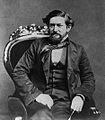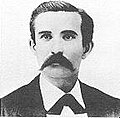Texas Military Forces
| Texas Military Forces | |
|---|---|
| Founded | 18 February 1823 |
| Country | |
| Allegiance | Major General Thomas M. Suelzer |
| Joint Staff director | Vacant |
| Executive Director | Shelia Taylor |
| Command Sergeant Major | CSM Frederick M. Heard |
The Texas Military Forces (TXMF) are the principal instrument through which the Texas Military Department (TMD) executes security policy for Texas, which has the second-largest population and border in the United States.[1]
The Texas Military Forces have a budget of $1.851 billion as of 2023.[2] Current forces include the Texas Army National Guard, Texas Air National Guard, and Texas State Guard of the Texas Militia. Former forces include the Texian Militia, Texian Army, Texian Navy, Texas Army, Texas Navy, and Texas Marines. It also included the Texas Rangers from their inception until 1935.[3]
The Texas Military Forces are administered by the Texas Military Department under command of the adjutant general of Texas, who is appointed by and subordinate to the governor of Texas, the commander-in-chief-in-Texas, and is also subordinate to the President of the United States, the commander-in-chief.[4]
History
Texas Military Forces are inextricably linked and have served an integral role in the development, history, culture, and international reputation of Texas.[5] They were established with the Texian Militia in 1823 (thirteen years before the Republic of Texas and twenty-two years before the State of Texas) by Stephen Austin to defend the Old Three Hundred in the Colony of Texas.[6]
Texas Military Forces sparked the
During the 19th century, the Texas Rangers' service in the Texas-Indians Wars and fighting outlaws significantly contributed to the folklore of the "Wild West".[13]
During the American Civil War, Texas Military Forces served under the command of Union and Confederate militaries. When the first units reached Virginia, Jefferson Davis greeted them by declaring: "Texans! The troops of other states have their reputations to gain, but the sons of the defenders of the Alamo have theirs to maintain."[14] The Texas Brigade achieved distinction as Confederate shock troops, while the Davis Guards maintained Texas as the only Confederate State, along with Florida, unconquered by the Union with their victory at Second Battle of Sabine Pass. It is referred to as the "Thermopylae of the Confederacy" and the most one-sided Confederate victory of the war.[15][16] Texas Military Forces also fought at the Battle of Palemito Ranch.[17]
Texas Military Forces have not waged a
Under command of the United States Department of Defense, Texas Military Forces have served in the Mexican War, Spanish War, Philippine War, Mexican Expedition, World War I, World War II, Cold War (Korea and Vietnam campaigns), and War on Terror. Since the September 11 attacks, Texas Military units have been deployed for the war on terror more than any other state.[18]
Administration
Texas Military Forces are administered by the Texas Military Department under command of the Adjutant General of Texas, who is appointed by and subordinate to the Governor of Texas, the Commander in Chief.[4]
Authority
Texas Military Forces exist under
Awards and decorations
Awards and decorations of the Texas Military are the medals, ribbons, badges, tabs, trophies, plaques, certificates, memorials, monuments, holidays, and general honors that recognize service and achievement in the Texas Military Forces.
Conflicts
The history of conflicts involving the Texas Military Forces spans over two centuries, from 1823 to the present, under the command authority (the ultimate source of lawful military orders) of four governments including the Texan government (in 3 incarnations), the U.S. government, the Mexican government, and the Confederate government.
Capability
After the United States Armed Forces, Texas Military Forces are the most capable, mission-ready forces in the United States.[22][23][18] They include infantry, paratroopers, special forces, armored cavalry, field artillery, communication, cyber, intelligence, support, medical, engineering, civil affairs, and weapon of mass destruction response units totaling over 23,000 service members. It also maintains a fleet of manned and unmanned aircraft with strike, reconnaissance, and transport capabilities, a fleet of rotorcraft, and a fleet of riverine watercraft. It maintains a statewide network of garrison, training, and monitoring installations. It maintains command and control through shelter and mobile tactical operations centers.[23][18]
Units
Texas Military Forces have undergone many re-designations, reorganizations, and reformations since 1823. Since 1846, Texas Militia units constitute the entirety of the Texas Military Forces.
Current forces
Texas Army National Guard
The Texas Army National Guard is the current
Texas Air National Guard
The Texas Air National Guard is the current air warfare branch of the Texas Military Forces for the State of Texas. It is composed of the 149th Fighter Wing, the 136th Airlift Wing, the 147th Attack Wing, the 254th Combat Communications Group, the 272nd Engineering Installation Squadron, and the 204th Security Forces Squadron. The 149th Fighter Wing prepares pilots for combat, the 136th Airlift Wing flies C-130s in-and out of theater and the 147th Reconnaissance Wing has recently acquired reapers to be the eyes in the hostile sky.
Texas State Guard
The Texas State Guard is the current state defense force branch of the Texas Military Forces for the State of Texas. It assists and augments Texas military and civil authorities in times of state emergencies, and in on-going support of National Guard units and local communities.
Former forces
Texian Militia
The Texian Militia was the militia forces of the Texian Colony from 1823 to 1835 and the inaugurate force of the Texas Military. It was established by Stephen F. Austin on August 5, 1823, for defense of the Old Three Hundred colonists against the Karankawa, Comanche, and Cherokee tribes; among others. Its most notable unit, the Texas Rangers, remained in continuous service of Texas Military Forces until 1935.
Texas Rangers
The Texas Rangers were established as a unit of the Texian Militia in the Texian Colony. During the Texas Revolution, it served as a unit of the Texian Army providing cavalry and conducting special operations such as demolition of Vince's Bridge and Immortal 32 relief force. During the Republic of Texas, it continued to serve as a special forces unit employing guerrilla warfare in the Texas-Indian Wars.































